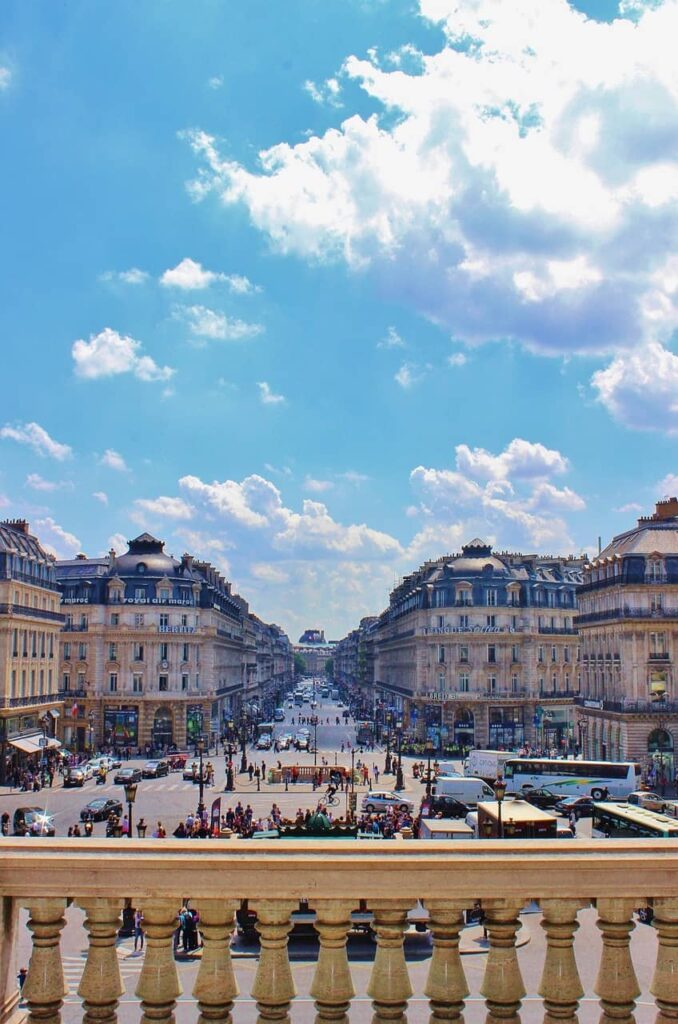Having lived in the City of Lights for a few years now, I’ve developed a bit of a love-hate relationship with this enigmatic, pulsating place.


Paris, with its history, art, and divine food, often feels like the perfect place. From the Eiffel Tower to the charming streets of the Latin Quarter, from the hustle and bustle around the Gare du Nord to the serene banks of the River Seine, there’s no denying that Paris is a city like no other.
Still, just like any other major city, it has its fair share of hiccups.
Here’s the catch – while Paris might be world-renowned for its chic cafés and iconic landmarks, it’s important to be aware of some areas in the city that might require a little extra caution, especially for first-time visitors.
As a local, I’m here to share some insider knowledge. I’ve put together a neighborhood-by-neighborhood guide, focusing on the ones that tend to have a higher crime rate.
Let’s dive into where not to stay while in Paris, and 10 not-so-great Paris neighborhoods to avoid:
⚡ Related read: Wondering where to stay while in Paris? Check out my guide to the best Paris neighborhoods here!




Is Paris Safe?
Let’s answer the big question first: Is Paris safe? The answer is yes, for the most part. However, like any large city, Paris has areas of concern that visitors should be aware of.
This 10-page Paris travel guide includes all the best foods to eat in Paris, where to eat, the top things to do and see in Paris, including day trips, scenic tours, museums, attractions, and more. Find out the best (and worst) places to stay in Paris, including my top picks for hotels in each area. Links in this PDF are clickable so you can book your tours and hotels directly!
Paris, known as the City of Lights, is one of the most popular tourist destinations in the world. It’s full of iconic landmarks like the Eiffel Tower and Arc de Triomphe, and neighborhoods rich in history and culture, like Le Marais on the Right Bank and the Latin Quarter on the Left Bank. It’s a great city to explore, with good public transportation and many areas that are easy to navigate on foot.
But here’s the thing – Paris, just like any other large city, is not without its safety concerns.
The 10th arrondissement, while known for its hip and vibrant atmosphere, has seen an uptick in crime rates in recent years. The same applies to the 19th district and the area around the Bois de Boulogne, particularly at night.
While they’re not necessarily the most dangerous places in Paris, they’re areas where it’s a good idea to stay alert.
Common scams and safety issues in Paris
There are a few major safety issues that tourists need to be aware of in Paris. These include petty theft and pickpocketing in crowded tourist areas and public transportation. There are also a few common scams targeting tourists around popular places.
There are even occasional violent crimes in certain parts of the city, terrorist attacks (though these are rare), and safety concerns around the red-light district in Pigalle.
P.S. This YouTube video is great for understanding some of the most common scams in Paris 👇
Paris safety vs other cities
How does Paris stack up against other major cities when it comes to safety? Well, compared to U.S. cities like New York or Los Angeles, Paris tends to have lower rates of violent crimes. Compared to other major European cities like London or Rome, Paris is similar in terms of crime rates.
The key takeaway? Paris is a relatively safe city, especially if you practice common sense, stay aware of your surroundings, and avoid less safe areas after dark. After all, there’s a reason Paris is one of the world’s most beloved cities.
⚡ Still worried? Check out my detailed guide on navigating Paris as a first-time visitor. It’s full of useful tips to help you stay safe and make the most of your visit.
10 Paris Neighborhoods to Avoid
1. La Chapelle/Pajol (18th arrondissement)
First stop, La Chapelle/Pajol. Nestled in the 18th arrondissement, it’s a bit of an odd one out, not your typical Paris neighborhood. You might know it for its proximity to Gare du Nord and Gare de l’Est, two of the busiest train stations in Europe.
This neighborhood can be a hustle. It’s the part of the city that never sleeps – for better or worse. I remember when I first moved here, I was living just around the corner, close to the metro station. It’s the place where I first discovered the blend of cultures that Paris hosts, with a vibrant African market, colorful street art, and a sense of community that you won’t find in many parts of the city.
However, in recent years, the crime rates in this neighborhood have seen a bit of a spike. It’s not uncommon to come across petty theft, especially if you aren’t paying attention to your belongings. I’ve had a couple of friends who lost their wallets around here, and trust me, that’s not the kind of Paris memory you want to take home.
So, what’s my advice for you? If you’re in the area to catch a train, stick to the main roads, keep an eye on your stuff, and you’ll be just fine. After dark, it might be better to opt for a cab rather than a lonely stroll, especially if you’re unfamiliar with the area.
Still, don’t let this dissuade you. The neighborhood has a unique flavor, and if you’re the adventurous type, you’ll find the diversity and buzz worth a peek. Just exercise a little caution, that’s all!
⚡ Related read: For more tips on how to navigate around the city while exploring Paris, you might find my Paris Metro guide useful.
2. Goutte d’Or (18th arrondissement)
Next up, we have Goutte d’Or. Another gem in the 18th arrondissement, it’s an eclectic mix of cultures that can be quite captivating. When I first ventured into this part of the city, I was immediately drawn to its lively, bustling vibe.
It’s a stark contrast to the quieter, more refined areas of Paris, but in its own unique way, Goutte d’Or is every bit as Parisian.
There’s this spot, right around the corner from the Barbès-Rochechouart metro station, where you’ll find the most delightful Moroccan bakery. I can’t even begin to describe the heavenly scent of freshly baked bread wafting from it early in the morning. But do remember, it’s a good idea to stay alert while enjoying your morning pastry.
Now, onto the less savory aspects of this neighborhood. The crime rates are unfortunately a bit high, mostly petty theft, but occasional violent crimes have been known to happen. I had a friend visiting from the States who had her purse snatched in broad daylight. Not the kind of adventure she had in mind, I assure you!
As with anywhere, it’s crucial to be aware of your surroundings and take sensible precautions. Keep your belongings close, especially in busy areas. If you’re out after dark, stick to the well-lit areas where there are plenty of people around.
Despite its challenges, Goutte d’Or is a vibrant neighborhood that showcases the diversity of this great city. It’s worth a visit if you’re looking for an off-the-beaten-path experience in Paris, but just remember to stay vigilant.
3. Château Rouge (18th arrondissement)
Now, we’re heading to our next neighborhood – Château Rouge. If you’re not careful, you might mistake it for a bustling bazaar in some far-flung corner of the world. It’s another pocket of the 18th arrondissement, just a stone’s throw from the Sacre Coeur and the bohemian haven of Montmartre.
Château Rouge is like a mini United Nations. It’s a melting pot of cultures where you can shop for exotic spices, vibrant textiles, and sample foods from around the world. I once bought a beautiful handmade Senegalese dress from a street vendor here – it’s one of my favorite Parisian souvenirs.
However, the vibrant street markets that give Château Rouge its charm are also a breeding ground for pickpockets and scam artists. It’s not the safest part of the city, especially for those unfamiliar with it. Once I was so engrossed in haggling for a pair of earrings that I didn’t notice someone trying to sneak into my bag. Thankfully, a local vendor noticed and shooed him away.
So, if you decide to explore Château Rouge, my advice is to stay extra vigilant. Keep your belongings close and don’t get too distracted by the hustle and bustle. It might be a good idea to explore this neighborhood during the day when it’s bustling with locals and other tourists.
💡 Remember: No place is entirely bad or good – every area has its own character and charm, even with its flaws. For more useful advice, have a look at my guide on things not to do in France as a tourist.
4. Stalingrad (19th arrondissement)
Let’s move on to Stalingrad in the 19th arrondissement. Not far from the Villette Park – a great place to picnic or stroll on a sunny day – Stalingrad is known for its stark contrast to the typical Parisian charm.
I remember the first time I visited, taken aback by the disarray.
But isn’t that part of city living?
Stalingrad, with its major metro and transit hub, connects the City of Love to the outer suburbs and other European cities. It’s a central location in the city of Paris and one of the busiest places in the city. The ’roundabout’ area with its beautiful rotunda is worth a quick photo, especially with the sun setting behind it.
Despite its bustling activity, Stalingrad has struggled with homelessness and related issues, particularly around the metro and the nearby train stations. In recent years, I’ve noticed more tents appearing under the metro bridges. The situation can sometimes escalate into skirmishes or heated arguments, which can be unsettling.
If you find yourself in Stalingrad, it’s important to exercise caution and common sense. Be mindful of your belongings, particularly in crowded areas. After dark, I recommend sticking to the main roads or opting for a taxi.
Related read: The Top 10 Best 4-Star Hotels in Paris
5. Belleville/Ménilmontant (20th arrondissement)
Belleville and Ménilmontant, nestled in the 20th arrondissement, are quite the duo. These neighborhoods are known for their street art, vibrant music scene, and stunning panoramic views of the city from Belleville Park.
It’s a different side of Paris that you might not see on typical tourist routes, but it’s worth a look if you’re up for a little adventure.
I remember when I first moved to Paris and my friends took me to a little-known spot in Belleville for a glimpse of the Eiffel Tower from afar. Sipping on a cup of hot chocolate, with the City of Lights spread out before me, was truly magical.
But as the sun sets, the atmosphere in these neighborhoods changes. It’s not as genteel as the Latin Quarter or as posh as the 16th arrondissement, and some parts can feel unsafe, especially for tourists. Late at night, the usually charming streets may seem a little eerie. And unfortunately, these neighborhoods have their share of crime, mostly petty theft but occasional violent crimes too.
If you decide to visit, it’s a good idea to stick to the main roads after dark and avoid isolated areas. Always be aware of your surroundings, and remember that it’s better to be safe than sorry.
6. Porte de Clignancourt (18th arrondissement)
Time to talk about another one of the 18th arrondissement’s neighborhoods, Porte de Clignancourt.
This place is famous for one thing: its sprawling flea market, known as the Marché aux Puces de Saint-Ouen. Whether you’re a vintage fashion enthusiast, a vinyl record collector, or an art lover, you can spend hours exploring the maze of stalls packed with unique finds.
On my first visit, I scored an original 1960s French poster that’s still the centerpiece of my apartment. However, while this might seem like the perfect place to hunt for unique souvenirs, it’s not without its pitfalls.
While Porte de Clignancourt can be a treasure trove, it’s also a notorious hotbed for petty crime. The narrow, bustling alleys of the flea market create the perfect environment for pickpockets to thrive. On more than one occasion, I’ve seen unsuspecting tourists fall victim to crafty thieves.
The area around the Porte de Clignancourt metro station can also be less than savory, especially as the day winds down. It’s a good idea to finish your shopping well before dark and keep an eye on your belongings at all times.
Despite these concerns, I’d still consider it a worthwhile experience, a peek into a less polished, more authentic side of the French capital. Just be sure to exercise caution and common sense.
7. Porte de la Villette (19th arrondissement)
Taking a stroll down the northeastern part of the City of Lights, we find ourselves in Porte de la Villette in the 19th arrondissement. It’s home to some of Paris’s gems that are often overlooked by the usual tourist circuit – like the science and technology museum, Cité des Sciences et de l’Industrie, and the vast Parc de la Villette, which often hosts outdoor cinema during the summer.
A few years back, I remember attending a fantastic jazz concert under the stars at the park. I still have that ticket stub tucked away in my memory box. But the area, particularly around the metro station, can feel a bit desolate, especially after dark.
In recent years, I’ve noticed an increase in drug-related activities and loitering around the metro station. It can be quite unsettling, especially if you’re alone or not familiar with the city. It’s a stark contrast to the peaceful green park and buzzing museum just a short walk away.
If you’re planning to visit, my advice would be to schedule your activities during the day and avoid walking around after dark. When you’re leaving, consider using a taxi or a rideshare service, especially if you’re unfamiliar with the area.
That said, Porte de la Villette is another testament to the multifaceted nature of Paris. It’s a slice of the city that shouldn’t be entirely disregarded. Remember to explore, but always prioritize safety.
8. Les Halles (1st arrondissement)
Let’s switch gears and head to the heart of Paris – the 1st arrondissement. It’s here you’ll find Les Halles, an area known for its central location and, notably, the vast shopping mall, Forum des Halles.
Nestled among iconic landmarks such as the Louvre Museum and Notre Dame Cathedral, it’s a bustling area popular among tourists and locals alike.
As a foreign student, I was initially drawn to the vibrancy and convenience of Les Halles. Who wouldn’t love living within walking distance of these famous sights, right? Plus, with the Châtelet–Les Halles train station, the largest underground station in the world, right there, it seemed like the perfect place.
However, it didn’t take me long to realize that, especially at night, Les Halles can attract some unsavory elements. Due to its popularity and high foot traffic, petty criminals, especially pickpockets, are rampant. There was an incident where a friend’s wallet got lifted right in the middle of the crowded mall – not the best memory from our Parisian adventure.
Now, don’t get me wrong. Les Halles is still a great place to visit for its shopping, food, and close proximity to the city’s heart. However, as is true in many busy areas of large cities, you need to be extra vigilant here. Keep your belongings close, and perhaps avoid the area late at night if possible.
⚡ Related read: For an in-depth understanding of Paris’s gritty side, check out this article where I debunk the stereotypes and give you the real scoop on the city’s cleanliness.
9. Porte de La Chapelle (18th arrondissement)
There’s one unsafe area in Paris that we definitely should talk about: Porte de La Chapelle, located in the northernmost point of the 18th arrondissement.
This area has gained some notoriety in recent years, and I’ve had my fair share of experiences here. In fact, I actually used to live here. The vibrant murals and graffiti that adorned the neighborhood give it a raw, authentic feel that’s different from the polished city center. However, it’s also an area known for its higher crime rates, particularly around the metro station.
Despite the cultural richness, you’ll often see signs of social issues such as homelessness and drug-related crimes, which are unfortunately quite prevalent.
There have been quite a few times when I was heading home late from a friend’s place and felt a little uneasy walking home from the metro station. I’ve since learned to arrange for a ride when traveling late or stick to well-lit areas and main streets when on foot.
10. Barbès-Rochechouart (9th/18th arrondissements)
Last on our list, but certainly not least, is Barbès-Rochechouart, a bustling neighborhood that straddles the 9th and 18th arrondissements. It’s a vibrant area, celebrated for its diverse culture, bustling street markets, and close proximity to the famous Sacré-Cœur Basilica and Moulin Rouge.
But beneath its lively veneer, Barbès-Rochechouart has its issues. The area, particularly around the metro station, can get crowded, and with crowd comes the usual suspects – pickpockets. Once, in the bustling market, I was so engrossed in negotiating over a beautiful set of hand-woven baskets that I didn’t notice a hand slip into my bag until it was too late.
After sunset, the atmosphere can change drastically. The crowded, bustling streets become eerily quiet, making it feel a bit uncomfortable, especially for tourists. It’s a good idea to stay alert and be aware of your surroundings when visiting the area.
Thanks for reading!
I hope you got some value from this guide to some of the less safe Paris neighborhoods. That being said, I hope that doesn’t discourage you from visiting them!
Just use a bit of common sense and brush up on a few local customs to blend in just a bit better – I’ve got a guide on how to do just that.
Related Reads
Planning a trip to Paris? Check out my guides on things to do in Paris, Where to Stay, What to Eat, and my tips on how to make your Paris trip a success!
- Where to Stay in Paris for the 2024 Olympics (Best Areas & Hotels)
- The 10 Best Rooftop Bars in Paris
- What Living in Paris As An American Is Actually Like
Hi, I’m Tiana – founder of and author here at Where Tiana Travels. I’m a 20-something with a love for all things travel, photography, and food. I have been living abroad for the past 5 years and solo traveling the globe in my free time. I created this blog to share my travel stories and inspire other women to go out and see the world. Read more about me here!



Cave-Montgomery-Young
Monday 15th of April 2024
That is a pretty comprehensive list of the unsavoury intra-muros areas of Paris. The easiest advice is not to go near any of them. Ever. Unless you're the sort of person who thinks it's edgy and diverse to go where criminals and sociopaths cluster. If you have to change trains at Les Halles, don't look clueless.
Tiana Thompson
Wednesday 17th of April 2024
Agreed! Looking like you know where you're going (even if you don't) is 100% the best advice I can give. I've always followed this rule everywhere I go and I've never been targeted